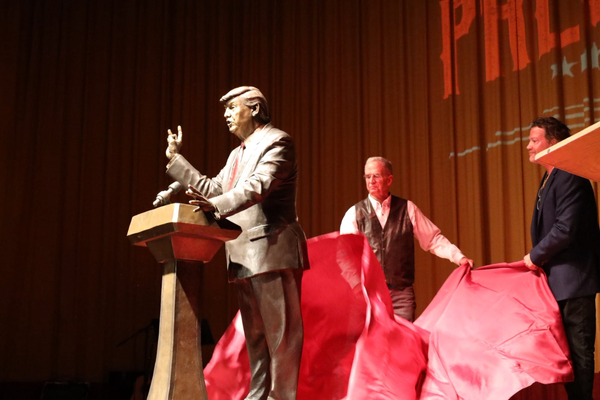
There is no hotter sauce in the world these days than Sriracha. And it is hot in two different ways. It’s hot because it is flying off the shelves and is the one Asian chilli sauce that famous Western chefs seem to love. The New York Times tells us that the three-Michelin star New York chef Jean-Georges Vongerichten uses it on tuna and to spice up a Hollandaise. In London, Yotam Ottolenghi has made it famous. Most trendy food truck chefs find some use for it. Food chains offer it along with ketchup. Even Walmart sells it to Middle America.
And it is hot in a second sense because, well, it is a hot sauce. At a time when the West is going crazy over the hotness of chillies, Sriracha has become the hot sauce of choice for Western foodies who brag about how much chilli they can endure.

Nearly a decade ago, I was first introduced to Sriracha in San Francisco. I liked it – to the extent that Indians, who have grown up on fresh chillies, can like any bottled chilli sauce. But I was not sure where it came from. The bottle said it was manufactured by the Huy Fong company, which sounds like the name of a mass-manufacturer of fortune cookies.
I was told that it was actually a Korean sauce because everyone in California bought it at Korean grocery stores and supermarkets.
This sounded reasonable enough to me. Then, a few years later, the Sriracha boom began. That’s when all the fancy chefs started using it and it became the trendy hot sauce for the American mainstream, edging out Tabasco.
I was intrigued by the passion that Sriracha evoked, especially among young people. So I tried it again. It was nice. But no, I couldn’t see what the fuss was about. Besides, I thought to myself, why didn’t I come across it in Korea?
Turns out, Sriracha is not Korean at all. And there is no Mr. Huy Fong. The company was created by a Vietnamese entrepreneur called David Tran in (where else?) California. Tran grew up in Vietnam, emigrated to the US, coming over on a freighter called Huy Fong (so that’s where he got the name from!) and setting up a sauce factory.

In the many glorious profiles I have read of Tran, he is always portrayed as embodying the American dream. The story goes like this:
Tran came with nothing. He remembered the chilli sauce that his family ate in Vietnam. And he resolved to recreate that sauce in America. When he first bottled it, he was told it was too hot for America. Why didn’t he add some tomato? But the courageous Tran defied the sceptics and bottled an authentic sauce.
And now that Tran is rich and successful, he is ‘very low-profile’. We know this because nearly every interview he gives contains at least one reference to his low-profile nature and his reluctance to give interviews.
So I had it completely wrong. It is not a Korean sauce at all. It is a Vietnamese sauce, right?
Ah well, not exactly...
The more I read about Tran, the more something kept nagging at the edges of my brain. Hang on! I said to myself. Isn’t there a town called Sriracha in Thailand near Pattaya?
There is, indeed. And that, in fact, is where the sauce originated, not in Tran’s genius imagination.
I discovered that I was not the first to make this point. Thais feel very strongly about the appropriation of their Sriracha by a Vietnamese American. They have said so with increasing levels of outrage.
The story seemed too good to resist. So last week, I took a plane to Bangkok and drove for two hours till I got to Sriracha (or Si Racha, both spellings are used).
A friend had arranged for me to meet Khun Keiengsak (Khun is a gender-neutral Thai honorific), who ran the last surviving Sriracha sauce factory in the town. There must have been a time when Sriracha was pretty but now, it is just another overdeveloped small Thai town with a population of 30,000.
Khun Keiengsak turned out to be a 70-year-old man of great dignity and, it must be said, great contempt for the claims made by the Huy Fong company. “This Vietnamese man,” he snorted, “came once to Pattaya (the resort is near Sriracha), tried the sauce and decided to make it. He always intended to make our sauce. Why else would he call it Sriracha?”
I said that as the plucky Tran of legend was an impoverished immigrant before he made his sauce, I did not think he could have come to Pattaya for a beach holiday at that stage of his life.
But Khun Keiengsak would not be diverted. “He says that it is a Vietnamese sauce from his childhood! They do not even have this sauce in Vietnam. If it is ‘Vietnamese’, why is it named after my town?”
Khun Keiengsak says his great grandmother set up the business. “I do not say that we were the first or that she invented the sauce but it has been in our family for four generations,” he explained. According to him, this is a popular sauce in the town and has always been made by several artisans, cooks and manufacturers.

Now, he runs the family business with the aid of his sister, Khun Russamee. They took me to their ‘factory’, which was more like a small artisanal workshop, located in one of the few unspoilt bits of Sriracha, with palm trees and a Chinese temple in the courtyard.
Khun Russamee explained the process. They buy red chillies (the same ones we use for cooking in India), cut off the stalks, and then boil and salt them. Next, the salted chillies go into a grinder, where they are pulverised till a smooth paste forms. This salt and chilli paste is then left to develop in large jars for between one to two months. When they judge that it is ready, it is mixed with sugar, garlic, salt and vinegar and ground again. Eventually, they add water and bottle the sauce.
I asked Khun Keiengsak if he had tried the Huy Fong sauce. He said yes, and it was clearly the same Sriracha sauce, made by the same method to the traditional recipe, but with extra chilli. Khun Russamee said she did not like it at all because “too hot, too hot!”

How had the ingenious Tran got hold of the recipe? I asked.
“Oh, it is not like building an atom bomb,” Khun Keiengsak laughed. “It is a traditional sauce of the region. Lots of people know how to make it.”
What did he object to in the Huy Fong version?
He had two objections. The first was that a good Sriracha is a balanced sauce. The Huy Fong sauce loses that balance in its eagerness to appeal to American chilli-heads. And the second objection was entirely predictable: “Why does he say it is Vietnamese? It is a well known local sauce. Just say that you are making a traditional Thai sauce. Why do you need to take it away from Thailand and say it is from somewhere else?”
Fair point. But how Thai is the Huy Fong version of the sauce? It’s a complex question, because there is no one Sriracha in Thailand, just as there is no one definitive brand of mango pickle in India. Each brand has its own flavour. There are mass manufacturers (though none of them still make the sauce in Sriracha) and there are artisanal makers like Khun Keiengsak and his sister. All of them make the same product but their sauces are not identical. So what do you compare the Huy Fong sauce to?
The editors of the Lucky Peach magazine, who know their sauces, say that Thai Sriracha sauces tend to be a ‘little more balanced’ while the Huy Fong sauce “is just straight heat and salt.”
That is my view too – using Khun Keiengsak’s sauce as a representative of Thai Sriracha. But mass market Thai Sriracha could well be different. Khun Keiengsak’s is a small production (the brand is Floating Island) and it is hard to find outside of Sriracha, even in Bangkok.
The New York Times used its own description of the Huy Fong Sriracha: “The truth is that Sriracha, as manufactured by Huy Fong, may be best understood as an America sauce, a polyglot puree with roots in different places.”
In other words, a Thai sauce as re-interpreted for Americans that denies its Thai provenance.
Don’t knock it: the re-interpretation has paid off.
The chilli-heads have turned the enterprising David Tran into a millionaire.
And nobody cares that Sriracha is a real place, or that the sauce originated there.
From HT Brunch, July 30, 2017
Follow us on twitter.com/HTBrunch
Connect with us on facebook.com/hindustantimesbrunch







